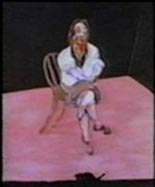
The difference in color between the image you see at left and the image represented at the beginning of the video version of Last Tango (below) highlights issues we should consider in our introduction to film study techniques: What types of distortion are inherent in different versions of or representations from the same film?

Bibliographical and textual scholars utilize the concept of "editions" to distinguish among different instances of a literary work, some of which they deem "more authoritative" or "less corrupt" than others. To what extent does this concept apply to film? How does the medium through which we view a cinematic work--i.e., 35mm film, video cassettes, or, even, digital video files on computers, condition our experience of that work?
Consider also that the image to the left carries certain potential for distortion: It was reproduced in a book, and, depending on the techniques used in that process, the image in the book may vary significantly from the original piece. To present the image to you, we scanned it from the book, adding another level for potential distortion, because even very expensive scanners cannot reproduce an image perfectly. Professionals can perform an operation called "color correction" to compensate for alterations introduced during processes of digital reproduction, but to do that they need access to a reliable version of the image. And they need to have great skill with professional image editing tools, such as Adobe Photoshop.
Professor Viscomi in the English department is one person at UNC working with issues and problems such as those we mention here. He is involved in a project called the Blake Archive, the goal of which is to eventually put all of Blake's images on the web. After someone scans the originals, they send the digital files to Professor Viscomi, together with accurate slide reproductions of the image that can be used as guides for the color-correction process.